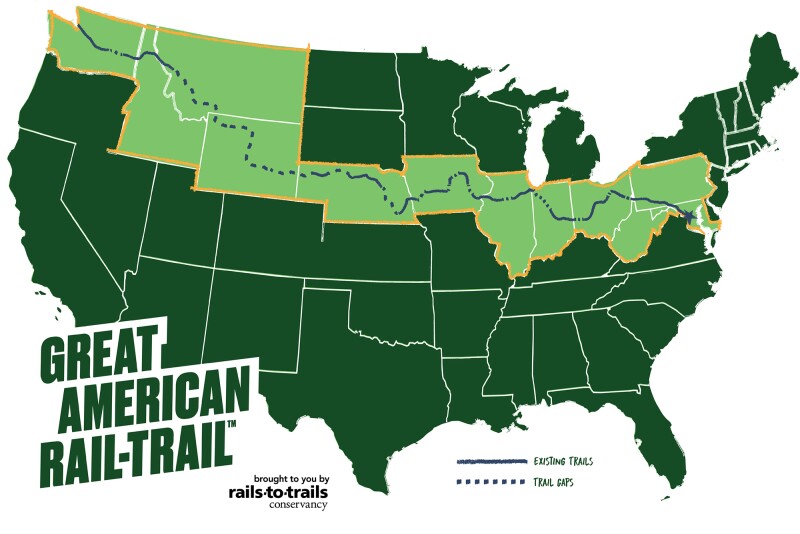A road trip may be the classic way to traverse the United States, but cyclists will eventually be able to make the cross-country bike trip a reality on a newly created trail system. Once it is completed, the Great American Rail-Trail will connect more than 3,700 miles of repurposed train routes and multi-use trails—all separate from vehicle traffic—across 12 states from Washington, D.C., to Washington State. Here’s everything we know about it so far.
Where will the route go?
In May, the Rails-to-Trails Conservancy (RTC) revealed the route that will connect 125 existing trails with another 90 “trail gaps,” or sections that will need to be developed to turn the new Great American Rail-Trail into one contiguous path.

The solid lines are the existing trails, while the dotted lines represent trail gaps that need to be built to connect the route.
Courtesy of Rails-to-Trails Conservancy
To see a more detailed view of the route, explore the interactive map here.
Twelve gateway trails will form the backbone of the coast-to-coast route. Starting in Washington, D.C., cyclists will begin their cross-country journey on the Capital Crescent Trail that begins in Georgetown and crosses into Maryland. From there the trail will be connected to the Chesapeake & Ohio Canal National Historical Park, a 185-mile trail that goes from D.C. to Cumberland, Maryland. Moving westward, the Great American Rail-Trail will then continue along the Panhandle Trail in Pennsylvania and West Virginia, the Ohio to Erie Trail in Ohio, and the Cardinal Greenway in Indiana.
In the Midwest, cyclists can then ride along the Hennepin Canal Parkway in Illinois, the Cedar Valley Nature Trail in Iowa, and the Cowboy Recreation and Nature Trail in Nebraska. Eventually, the route will enter the Casper Rail Trail in Wyoming, before moving along the Headwaters Trail System in Montana, and the Trail of the Coeur d’Alenes in Idaho, then finally ending along the Palouse to Cascades State Park Trail in Washington.
When will it be completed?
By working with local trail organizations, the RTC aims to fill critical trail gaps in the cross-country route as efficiently as possible. Currently, the RTC says that the projected route is 52 percent complete and many of the trails that need to be built to connect the route from state to state are already in state and local trail plans.
However, the RTC says it will take at least another few decades to complete the full route, because it needs to work across state lines and jurisdictions to make sure the existing trail network is well-aligned across the country. But segments will open to the public each year, making it easier to travel throughout the country on bikes in the meantime.
Once completed, about 50 million people will live within 50 miles of the route, making it easily accessible to many Americans.
How is this different from the U.S. Bicycle Route system?
The Great American Rail-Trail is similar to the U.S. Bicycle Route (USBR) system in that it allows for long-distance bicycle travel throughout the United States. But while the USBR system provides low-traffic routes for cyclists between 26 states and Washington, D.C., the Great American Rail-Trail—which will also be accessible to pedestrians—will be built along out-of-use train tracks and car-free pathways to alleviate the stress of sharing the road with cars. At the moment, the RTC says that the current route is about 80 percent off-street, but it is working toward being 100 percent off-street.
This article originally appeared online in February 2019; it was updated on May 8, 2019, to include current information.
>> Next: Chile Opens 1,700-Mile Hiking Trail Connecting 17 National Parks











